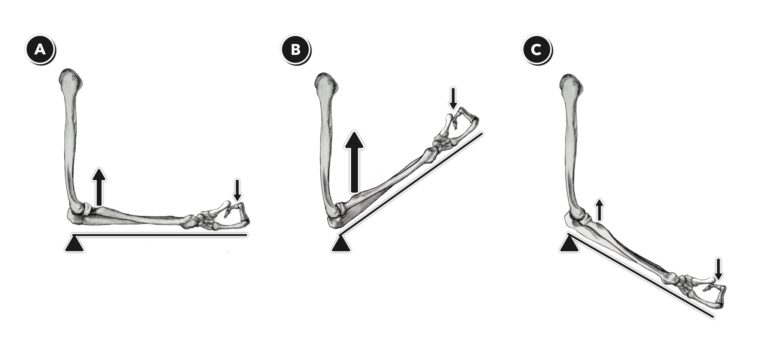A third-class lever is another example of a simple machine comprising a beam placed upon a fulcrum. The third-class lever differs from the second-class lever in that the distribution of forces is changed in relation to the fulcrum. In third-class levers, the fulcrum remains at one end of the beam—however, the force of the effort is now located between the fulcrum and the force of the load.
If the moments of the effort and load are equal, then the system is in equilibrium: No movement occurs (Figure 1A). Note that for equilibrium to occur, the force of the effort must be greater than the force of the load, due to the load’s mechanical advantage. If the effort contributes a greater moment than the load, the beam will pivot in the direction of the force of the effort (Figure 1B). If the load contributes a greater moment than the effort, then the beam will pivot in the direction of the force of the load (Figure 1C).
Third-class levers are plentiful in human anatomy. One of the most commonly used examples is found in the arm. The elbow (fulcrum) and the biceps brachii (effort) work together to move loads held with the hand, with the forearm acting as the beam. In this anatomical example, when the contracting bicep creates a moment about the elbow equal to the moment of the load, the system is in equilibrium. The forearm remains static, and the load does not move (Figure 2A). If the moment created by muscular contraction is greater than the load supported by the hand, then the forearm and load will rotate upward, as in a curl (Figure 2B). If the moment created by the load is greater than the muscular contraction, the forearm and load will rotate downward (Figure 2C).
Related
Comments on Anatomy of Levers, Part 4: Third-Class Levers
If you've heard athletes talk about "muscle insertion points", this is where and why they matter.
To get a little mathy, the formula governing how much effort is required to move a resisting force around a third-class lever is:
Effort = Resistance * (Distance to Resistance / Distance to Effort)
where distances are calculated from the fulcrum.
In this formula, "distance to effort" is in the denominator. What this means is that to move the same amount of resistance, at the same distance, we require half as much effort if we double the distance between the fulcrum and the load.
In our joints, that "Distance to Effort" is the distance between the joint and the insertion point of the muscle - that is, the point at which the muscle attaches to the bone across the joint. So for a bicep curl, in theory, if your bicep were to attach further from the elbow joint, you would need less contractile effort from the muscle to lift the same weight than if it were attached closer to the joint.
I don't know if the variability between athletes is great enough to be practically meaningful, and I don't see insertion points brought up as much as they used to be, but conceptually they're significant.
(Source: https://www.engineeringtoolbox.com/levers-d_1304.html )
(And for reference: https://www.healthline.com/human-body-maps/biceps-brachii)
Thanks for explaining this


Anatomy of Levers, Part 4: Third-Class Levers
2